Cherry pruning in spring: schemes, rules and advice for beginner garden "surgeons"
Sweet cherry is a culture that gives fruits amazing in taste. But like any other plant, it needs some care. Experienced gardeners know that without proper pruning of cherries, it will not be possible to achieve a stable and high-quality harvest, because cherries have a very intense growth force.
About when and how to prune cherries in spring, as well as the rules for shaping young trees - read on.
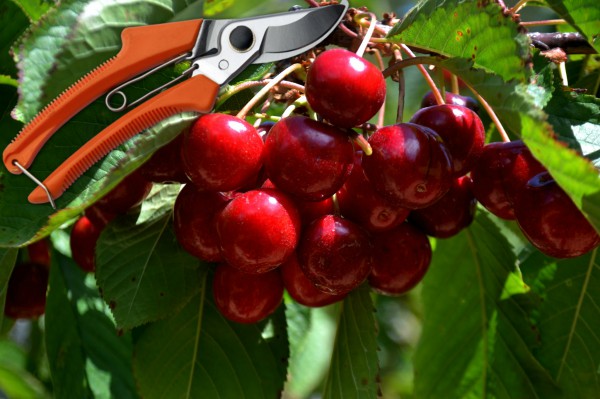
Content
- 1 Why prune cherries: the purpose and objectives of spring pruning
- 2 When to prune cherries in spring: optimal timing
- 3 Preparing for spring pruning of cherries
- 4 Basic rules and technique for pruning cherries
- 5 What branches to cut and prune from sweet cherries in spring
- 6 How to prune young and old cherries: shaping and rejuvenating pruning
- 7 Popular mistakes that occur during spring pruning of cherries among beginners
Why prune cherries: the purpose and objectives of spring pruning
The main purpose of pruning a sweet cherry (like any other plant) is to increase the quantity and quality of the crop, as well as your concern for the health of the tree itself (so that it will bear fruit for as long as possible and delight you with rich and tasty harvests).
Thus, by pruning cherries in spring, you solve the following tasks aimed at achieving the above goal:
- improved access to sunlight;
- ensuring optimal ventilation inside the crown;
- disease prevention.
In other words, spring pruning of cherries is carried out in order to:
- to form a tree correctly so that it has a comfortable crown and gives stable yields;
Also, thanks to the formation of the correct crown by cutting it behind the tree, it becomes easy to care for, and the most important thing - harvest.
- adjust the growth of the tree, i.e. increase or decrease;
- eliminate the frequency of fruiting (so that a situation does not arise when one year the plant bears very abundant fruit, and the next - weakly);
- improve the quality of the fruits (after correct pruning, the fruits become larger and tastier).
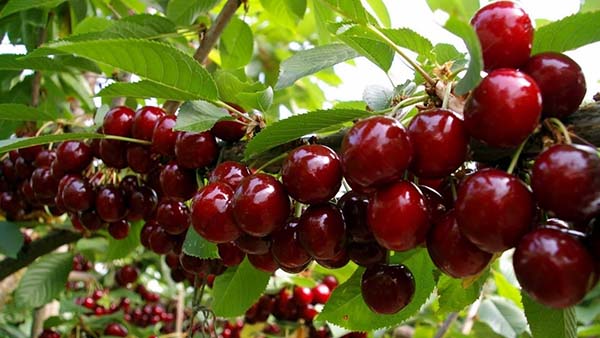
When to prune cherries in spring: optimal timing
Spring pruning of cherries must be done before the start of sap flow (those. before bud break), in other words, when the tree should still be sleeping.
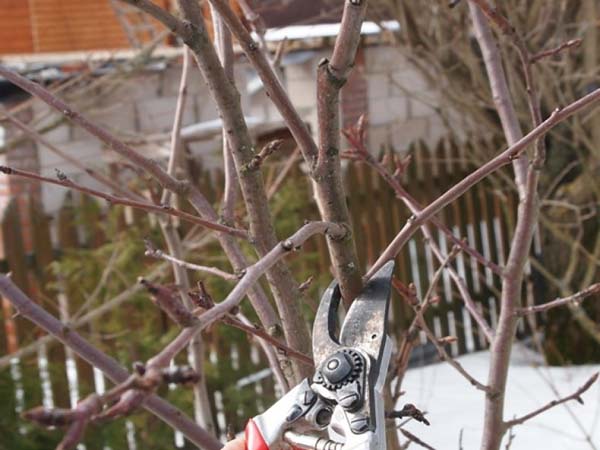
Controversial! At the same time, some gardeners advise to carry out the procedure when sub-zero temperatures are still confidently holding (but not lower than -10 degrees), while others recommend that the air temperature, on the contrary, be positive (about +5). In any case, the duration of the pruning period is before bud break.
Of course, it is quite difficult to name the exact dates: spring in different regions starts at different times depending on the climate. The main thing is to be in time before the start of sap flow.
However, one can call approximate (tentative) terms... So, the pruning of cherries in the spring in the Middle Lane (Moscow region), as a rule, is carried out already in late March - early April, in the South of Russia - in late February-March. And in more northern (in the North-West - in the Leningrad region) and cold regions (in the Urals and Siberia), spring pruning of sweet cherry is carried out in the second half of April.
When is the best time to prune - in spring or autumn
According to most agronomists, the best time to prune fruit trees is early spring, and you must be in time before the start of sap flow... In addition, the shorter the time between pruning and the start of sap flow, the better. In addition to conserving energy, with the beginning of sap flow, the tree's own defense mechanisms "turn on", which means that pathogenic organisms have practically no chance to penetrate into the "tree system".
As for the autumn pruning, it noticeably weakens the trees, their winter hardiness decreases. Therefore, it is believed that only winter-hardy breeds (varieties) can be cut in autumn, which tolerate frost well and are not at all afraid of freezing.
Note! There is a rather controversial opinion that only pome crops (apple trees, pears) can be cut in the fall, but stone fruits (apricots, peaches, plums, cherries, cherries) - only in the spring.
In addition, in autumn, trees, on the contrary, suspend any active defense (their own defense mechanisms), while fungal spores are still flying in myriads. In addition, with the onset of frost, the cambium freezes over, and it becomes difficult to overgrow the wounds after pruning.
Thus, it is better to prune cherries in spring. Autumn pruning is resorted to only if in the spring you have little time (you did not have time) or / and the variety is frost-resistant enough.
As for the time, the autumn pruning of cherries can be started when all the leaves of the tree have completely fallen off.At the same time, it is important that the air temperature is positive, since trimming must be completely stopped already at a temperature of -5 degrees. It is in such conditions that wood freezes and becomes brittle and brittle.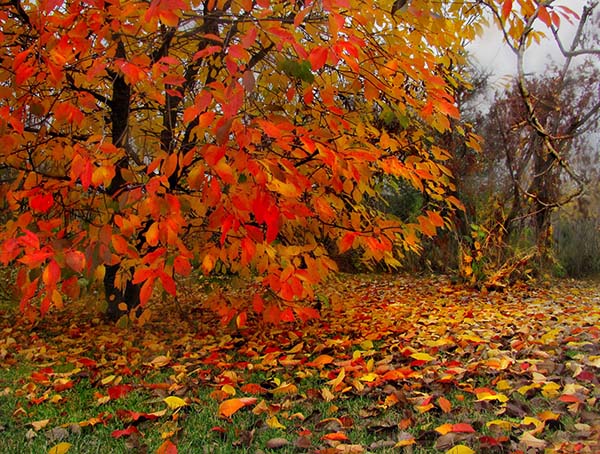
Preparing for spring pruning of cherries
Every novice gardener must first understand the structure and structure of his cherry tree himself, in order to then better understand the basic rules for pruning it. And, of course, have all the required tools in your summer cottage arsenal. Let's start with them.
Tools
To carry out work on pruning cherries, you will need the following tools and products for treating wounds after pruning:
- regular manual pruning shears (for thin branches);
- garden knife (for very thin branches and for deburring);
- garden saw-hacksaw (for thick branches);
- secateurs with long handles (for upper thin branches);
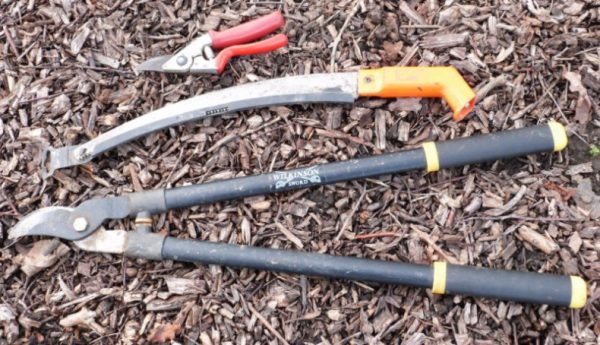
- stepladder (for the convenience of removing the upper branches);
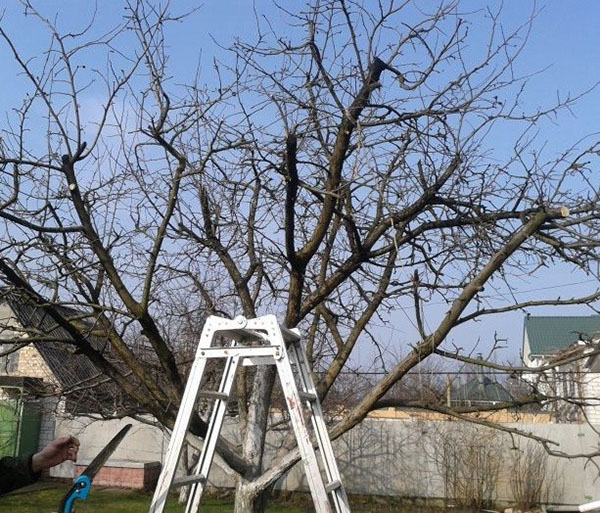
- oil paint (based on drying oil) or just natural drying oil, linseed oil or brilliant green. Alternatively, you can mix iodine and alcohol (1 to 1) or buy a garden var or special Rannet paste.
Advice! The entire instrument must be in proper and prepared condition - the pruner must be sharp (sharpened) and clean (or even better, before trimming it, disinfect it, for example, with the same Chlorhexidine).
The structure of the tree: its structure
Before you start pruning, carefully examine your cherry, its silhouette. And then figure out which branches clearly look superfluous (in accordance with the rules below) and only then proceed with the direct pruning.
According to the rules, any tree should have a balanced or, more precisely, a crown evenly branched in all directions.
Thus, in order to carry out pruning according to all the rules, you need to know the structure of the tree. Therefore, first it is worth studying and understanding its structure:
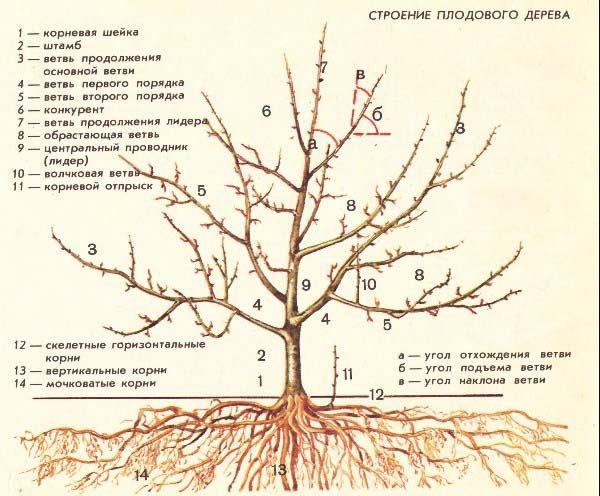
You also need to be able to distinguish branch age, which is determined by the annual bud rings located at the base of the annual growths.
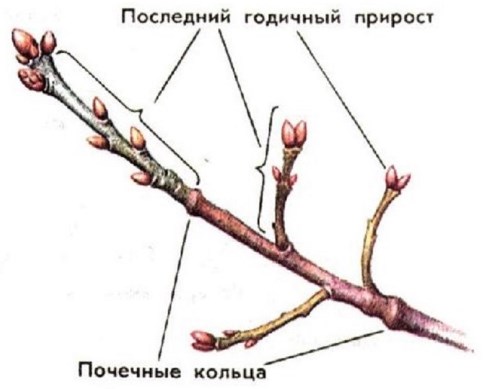
It is also important to distinguish kidney types:
- vegetative (growth, leaf) - from which new shoots and leaves develop (they are smaller and can be easily seen on a one-year growth);
The bud at the top of the shoot of a sweet cherry is always growing.
- fruit (floral) - from which flowers are first formed, and then fruits (larger ones are located on fruit wood).
By the way! Fruit wood is usually called 2-6 years old. Accordingly, as a rule, cherry fruit buds are laid on 2-4 year old wood, however, in rare cases, they can also be laid on a one-year growth.
Thus, you must easily distinguish between fruit formations and twigs so that they are not accidentally removed when pruning!
Important! Fruit formations of sweet cherries (like all stone fruits) are rather short bouquet branches, as well as long spurs (fruit branches).
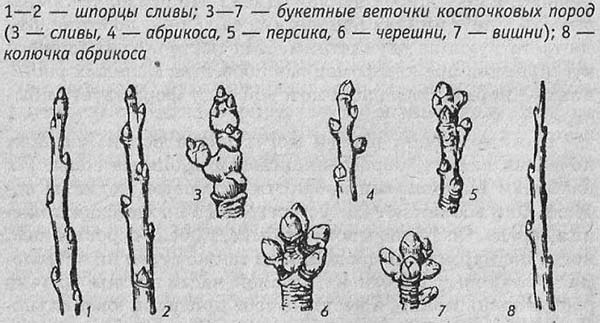
Types and methods of trimming
Before moving on to the types and methods of pruning, you should familiarize yourself with the age periods that each fruit tree (including cherry) goes through:
- growth vegetative parts;
- growth and fruiting (from first fruiting to stable yields);
- fruiting and growth (from stable fruiting to maximum yield, while the activity of growth processes gradually decreases);
- fruiting (maximum yield);
- fruiting and drying out (growth processes die out, fruiting begins to decline).
According to them, there are various types of trim:
- Formative (for young trees) - helps to form a crown of the correct shape and create a strong tree skeleton.
- Regulatory or pruning for fruiting (for fruiting ones) - to regulate fruiting, improve the quality and quantity of fruits, as well as extend the productive period of the fruit tree's life.
- Anti-aging - (for old trees) - for their rejuvenation. However, it is usually held in several stages every spring.
- Sanitary - it is used for trees of all ages in order to clean the crown from diseased, dried and broken branches. It is carried out as needed, regardless of the season.
As a general rule, all types of trimming are generally recommended.
There are also pruning methods (sometimes mistakenly referred to as species):
- Shortening - during such pruning, the shoots are not cut completely "into the ring", but only are shortened by the "kidney" (as a rule, to the external one), which enhances the branching of skeletal branches and stimulates fruit formations, and also serves to subordinate the branches and rejuvenate the wood.
You can shorten both one-year growth and perennial branches.
There are 3 types of shortening: strong (by 1 / 2-1 / 3), medium (by 1 / 3-1 / 4) and weak (by 1/5).
Strong - for the formation of strong shoots, weak - for laying fruit wood.
In this case, the degree of shortening also depends on the length of the annual growth.
- if the growth is less than 40 cm, then usually they are not shortened,
- if the gains are 50-70 cm, then they make a slight shortening (by 1/5 of the increase),
- if more than 70-80 cm, then 1/4 (average),
- if more than 1 meter, then a strong shortening is carried out (by 1/3 or even 1/2).
Note! Bouquet cherry twigs are laid on the shoots of last year in the middle of the branch, so you only need to shorten it by 1 / 3-1 / 4. If you make them shorter, this will cause a strong growth of shoots and as a result it will turn out so that every year we will only cut, thereby delaying the harvest in time and in height.
- Thinning - is carried out in order to rid the tree of unnecessary shoots that thicken and shade the crown. In this case, the branches are completely removed. "On the ring".
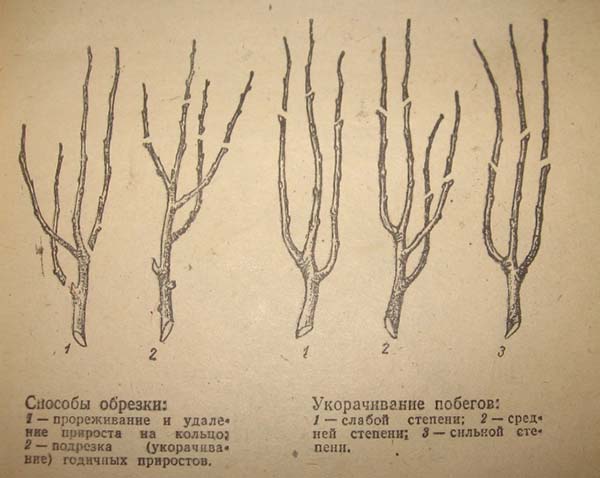
Remember! The more light will fall on branches, so above will be yield... A no thickening and good air circulation inside branches - reliable protection against fungal diseases.
Video: how to prune cherries: biological characteristics of cherries, formation tasks, pruning principles
Basic rules and technique for pruning cherries
Consider how to act during pruning: how to hold the pruner and how to directly prune the branches.
The principle of subordination of branches
It is very important to observe the principle of subordination of branches, that is, all side branches (skeletal branches) obey the guide (central trunk) and should not be higher than it. This also applies to growth on skeletal branches.
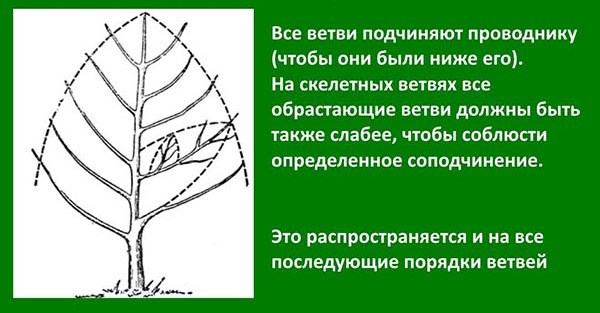
How to hold a secateurs
Pruning shear blade should be always below.
Wrong, if the pruner is facing downward with an emphasis, not a blade.
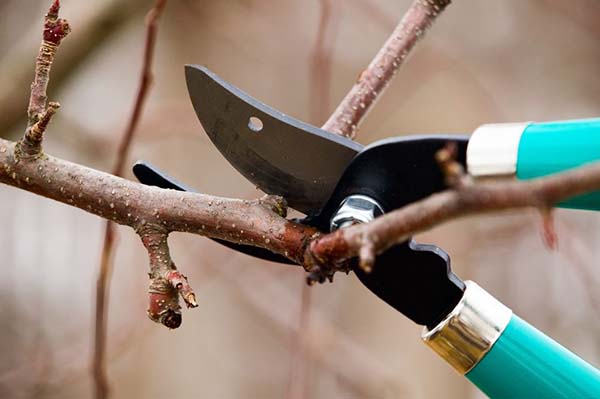
As for the cropping technique, when you remove branch completely, trimming is done "On the ring" (most often "for translation") when cut only partthen "Kidney"... Let's consider further in more detail.
Kidney pruning
The essence of this pruning is that when you thin out the crown, it is not at all necessary to cut the young branch completely. It is much more effective to prune it to the outer bud (facing outward upward, not inward or downward) to change the direction of its growth. In this case, it is necessary to cut in such a way that the top of the cut reaches the top of the kidney, and the base of the cut is at the level of the base of the kidney. Then the cut will heal well.
Worth knowing! Do not get carried away with pruning "to the kidney", because many small cuts weaken the tree much more than a few large ones.
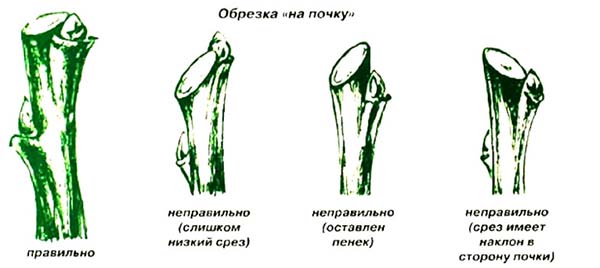
Important! You need to cut on the growth (vegetative) kidney, but not on the flower (fruit). See differences above (vegetative less than fruit).
Cutting "to the ring"
The point is to completely cut the branch, and you need to cut it along the trunk (along the annular ridge - a thickened ridge at the base of the branch), namely, the saw line should pass along the bisector between the axis of the trunk and be perpendicular to the branch.
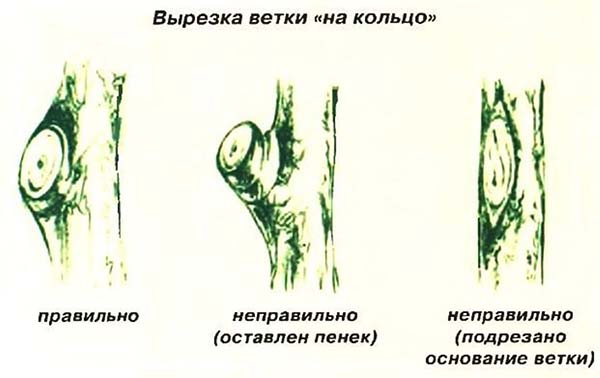
Rules for 3 cuts (cuts)
When pruning old and thick branches on the "ring", adhere to the rule of three cuts (cuts):
- It is always necessary to cut a branch from the bottom, otherwise it may break under its own weight (weight), due to which a bark seizure forms (similar to a torn burr on a finger). Thus, during the first cut, the branch is cut by 1/3.
- The next cut is done already from above, while noticeably higher than the first. As a result, the branch is completely cut (otherwise it may break off).
- As a result, you will have a stump, which will need to be cut down with the third cut, while making it from above exactly "along the ring" (perpendicular to the branch trunk), leaving an annular overlay.
If any burrs remain, they should be trimmed with a sharp garden knife.
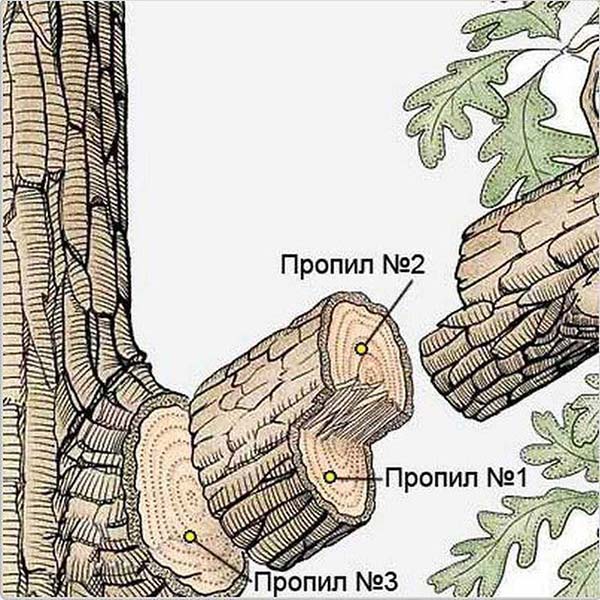
This is the only way to get a neat and correct cut.
Cropping "for translation"
Prune branches "On the ring" need to only "for translation", i.e., on a branch or shoot, which will further provide the cut with nutrients and heal it. In this case, the branch (shoot) of the supply should be no thinner than 1/3 of the cut diameter.
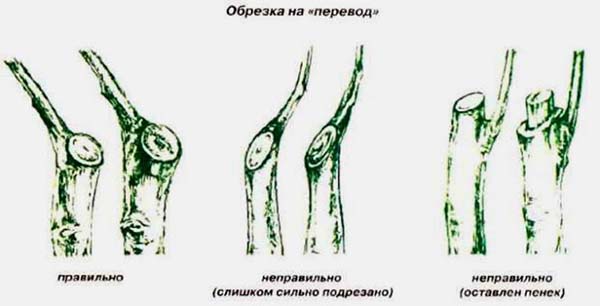
Other important pruning rules:
- Cropping should be balanced... If pruned heavily, the plant will sprout many shoots and yield low yields. If, on the contrary, it is poorly pruned, then the harvest will be too much and the frequency of fruiting may occur (the next year there will be nothing). Usually, at once recommended cut no more than 1 / 4-1 / 3 crown, this especially applies to old trees, including when they are "rejuvenated".
- Vertical branches (tops) are actively growing, and horizontal ones bear fruit.
Treatment of wounds (sections) after pruning
The wounds (sections) remaining after trimming must be processed according to all the rules:
- To prevent moisture from entering the cut and rotting (due to a fungal or bacterial infection falling into the cut), it should be covered with a special agent. As a rule, this is used garden var.
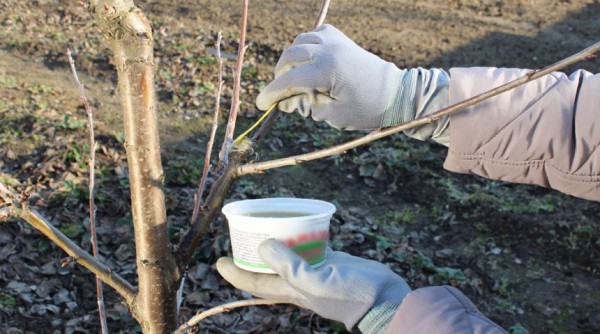
Important! According to some gardeners, garden var is more harmful than beneficial. Now a more effective and useful remedy for treating wounds after pruning is a garden paste-putty "Rannet"... However, if there are still frosts (even small ones), then processing with oil paint will be more effectivesince garden var and "RanNet" paste at subzero temperatures can freeze and peel off. Also fit natural drying oil, linseed oil and brilliant green (everyone does not freeze). And you can mix 1 to 1 iodine and alcohol.
- Obviously, the smaller the cut area, the easier it is for the tree to heal the wound. So if a cut with a diameter of up to 2-3 cm, then it is not smeared at all. Have very large cuts only need to be processed at the edges to protect the cambium from drying out.
- It is especially important to cover up large sliceswhich are made "on the ring "on skeletal branches and trunk.
If cancerous ulcers form on them, then it will be very difficult to cure them, which means that you can lose the skeletal branch or, even worse, the entire tree (if on a trunk).
- But when pruning "Kidney" the cut diameter is small enough and does not need processing.
What branches to cut and prune from sweet cherries in spring
Now let's consider which branches are subject to complete removal, and which ones only need to be cut.
ATTENTION! Be sure to read the material to the end and only then proceed to pruning your cherries.
In order not to harm the plant instead of benefit, it is required to strictly follow the rules for pruning.
- First of all, you need to delete all diseased branches... Moreover, they need to be postponed separately, and then destroyed, burned.
Important! BOlives should be trimmed to healthy wood. In this case, it is advisable to do this "On the ring", method "For translation".
- Also all broken and broken branches, which, most likely, are also affected by some kind of disease.
- Get rid of everyone crooked branches (growing through other branches or crossing, "rubbing against each other") and from branches growing inside the crownthat shade good branches.
By the way! Such branches can be removed completely (by cutting "into a ring"), or they can be translated "to fruiting" by cutting "to a bud", while it must look outward (if you do the opposite, the operation will be meaningless).
- Absolutely not needed branches growing at a very sharp angle (ie, their angle of departure is less than 40-45 degrees) and forming the so-called "forks". They are also cut out
Due to the load of fruits, such a branch can simply crack and a severe wound is formed.
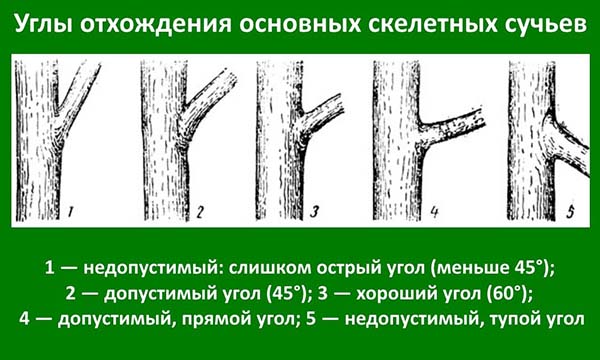
- As you understood from the picture above, in addition, you need cut off all branches growing down (at an obtuse angle).
- Are subject to removal all tops (vertical shoots on skeletal branches, they are also called "wen"), and root suckers.
By the way! Tops can be used for spring grafting of sweet cherries.
- You also need to cut all shoots below the first tier (so they don't hang directly above the ground).
In short, pruning all unnecessary and interfering branches, which thicken and shade the crown, and also make it difficult to ventilate the tree.
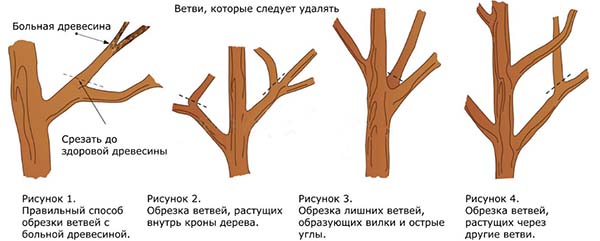
- Very important leave no competing branches (or thus replace old ones with new ones), cutting them "For translation".
This is especially true for branches competing with the conductor (main trunk). For example, if they have already become the same thickness, and both tend upward.
However, thick branches should not be pruned in one year. It is better to first remove most of the branches of the second order, and the next year to get rid of the competitor completely.
- For the best branching and stimulating fruit formations can be shortened "On the kidney", 1/3 (to the external kidney), all continuation branches — one-year increment.
Note! It is not necessary to shorten the already short branches (up to 20-30 cm), on the tips of which there are flower (fruit) buds - they have the whole harvest on them. Long (more than 40-50 cm) annual growth branches (with vegetative buds) are subject to pruning.
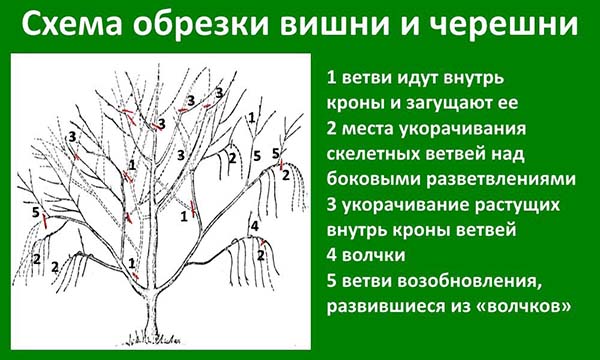
So by trimming the tree, you can change the direction of its branching. In this case, it is necessary that the cherries horizontal branches predominated. From vertical is it worth either get rid of completely, or artificiallyredirect them.
Bending branches to increase the angle of departure
Advice! It is not necessary to prune all good vertically growing branches. To make them more horizontal, you can bend down, pulling the rope down and tie to a peg in the ground or directly to a tree.
However, it is worth knowing that in stone fruits, the laying of spurs (fruit twigs) can also occur on vertical shoots, but in pome fruit branches (twigs) are laid mainly on branches with an arrangement of 45 degrees.
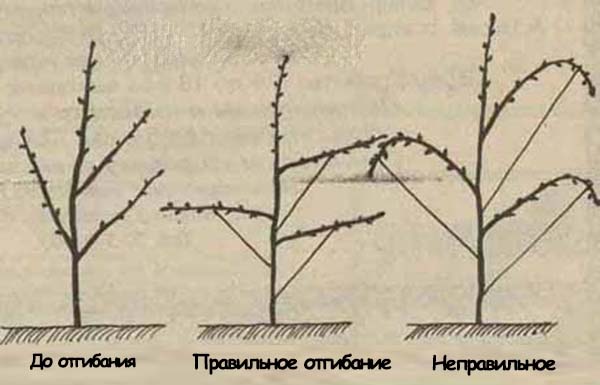
Cyclic trimming
The fact is that after 4-5 years the skeletal and semi-skeletal branches begin to "grow bald", fruit formations cease to form on them, and all the fruit wood goes up far from the center of the crown.
Therefore, 4-5 years after planting, every year, you will need to cut one of the thickest skeletal branches of the first or second order (semi-skeletal). Naturally, this should be done by cutting into a ring, transferring to another, younger (2-3 year old) side branch.
How to prune young and old cherries: shaping and rejuvenating pruning
Depending on the age of the trees, the specificity of pruning also differs - the formation of a young cherry tree (from the moment the seedling is planted) and the rejuvenation of the old culture.
For young seedlings, a shaping procedure is carried out, which helps to form the crown and strengthen the skeleton of the tree. For old trees, a rejuvenating procedure is applied, the purpose of which is to restore the regularity of fruiting.
Ways (types) of forming cherries: types of crowns
Remember that any trimming must be repelled by the shaping!
However, one must understand that shaping and pruning are different actions. If you can still “freak out” with shaping (go into creativity), then you need to make cuts only according to the rules.
The method of formation depends on the tree's vigor and branching ability.
By the way! It is believed that sweet cherry branches are very weak, and one-two-year-old shoots may not have any branches at all.
It is also important to know what exactly you want to get: a lot of fruits or you just need a beautifully designed tree.
Types of tree crowns: methods of formation
- discharged-tiered;
One of the most popular types of fruit trees, including sweet cherries.
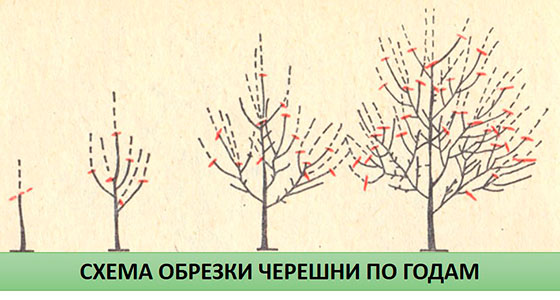
- cupped (vase-shaped);
- spanish bush (SB - Spanish Bush);
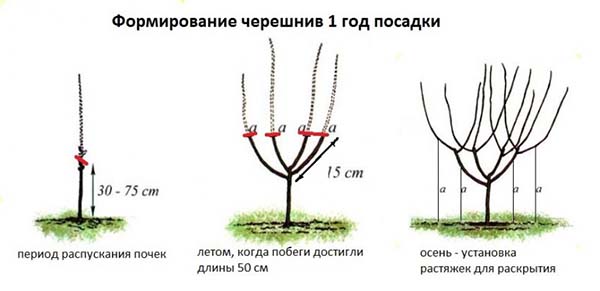
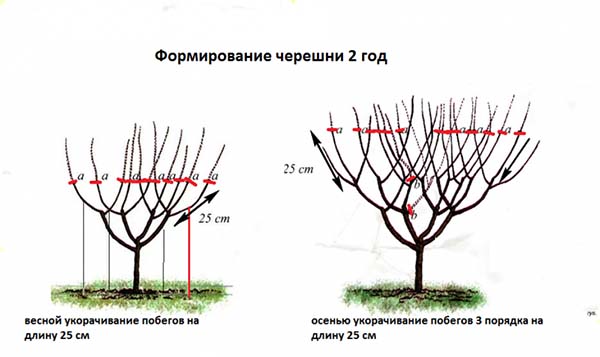
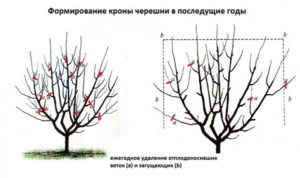
- improved spanish bush or according to the KGB system (KGB - Kym Green Bush, this is the name and surname of the Australian gardener, therefore this formation is also sometimes called the "Australian bush");
It is the KGB and SB formulations that are most popular in industrial horticulture. Actually, therefore, many amateur gardeners have taken them into service and on their personal plots.
- according to the Vogel system (T. Vogel).
Note! Further in the step-by-step instructions, you will be told about simpler types of formations, namely, discharged-tiered and cupped. And you can learn how to form a tree like the Spanish (in the pictures above) and the Australian bush from the following videos:
Video: how to form a tree according to the Spanish bush system
Video: the nuances of forming cherries according to the KGB system
Sparse-tiered cherry formation: pruning a 1,2,3,4-year-old tree
As a rule, young cherries are formed every spring, but autumn formative pruning is also allowed (although this is highly undesirable).
Note! Which branches to delete, and which ones to leave, how exactly to cut them - everything is detailed and clearly shown (in the diagrams) in the previous paragraphs.
Next, we will consider how to form cherries correctly if you have chosen a low-tiered type of formation:
Note! As a rule, a 1-2 year old seedling is already planted..
- right after spring planting (that is, we already have a 1 or 2-year-old seedling) - the main branch (central conductor) is cut off, or rather the top is 3-4 buds (leave a height of 80-100 cm) so that lateral branches form at the tree, otherwise speaking, the first tier was formed.
It is better to break out all the lower buds so that the tree directs all its forces to the development of the top - the future skeletal branches of the first tier.
- for 2 years - lateral branches are formed near the tree, which should be cut off by 1/3 of their length (to the outer bud), and only 2-3 of the strongest (ideally - 3), growing horizontally in different directions, should be left, and the rest should be cut into a ring. You should also trim the top of the central trunk (conductor) to a height of 60-80 cm from the branching of the first tier (from the uppermost lateral branch) so that the next (second) tier of skeletal branches begins to form. AND do not forget about subordination (trimming should be carried out at the same level).
Worth knowing! The distance between the tiers of skeletal branches should be approximately as follows: 60-80 cm - between the first and second tier and 30-50 cm - between the second and third. Between the branches themselves in one tier - 10-15 cm. The height of the trunk is 50-80 cm (but 80-100 cm is also possible).
- for 3 years - the lateral branches are cut off again, as well as the young growth (branches of the second order) on these branches, again by 1/3, "per bud". In addition, now you need to leave 2-3 branches (ideally - 3) of the second tier, also cutting them by 1/3. The top of the central trunk is trimmed again, but already 30-50 centimeters from the second tier, so that the next (third) tier is formed.
The central conductor (main trunk) should be one, therefore all its competitors should be cut off "on the ring".
- for 4 years - the last year of cherry formation (if you form in 3 tiers). Everything is done similarly to the previous year (the continuation shoots are shortened and the side branches are cut off), with one exception: if 3 tiers are enough for you, then 2 strong shoots are left for the 3rd tier, the top itself is cut "into a ring", by transferring to a side branch (3 branch).
Remember to follow the principle subordination of branches, Tier 1 - the longest branches, tier 2 - shorter, tier 3 - the shortest.
- For 5 years and beyond it is already necessary to carry out anti-aging pruning, and also not to overlook sanitary and thinning.
Advice! The optimal height of a tree from which it is convenient to harvest is no more than 3.5-4 meters, and even better, 2.5-3 m.
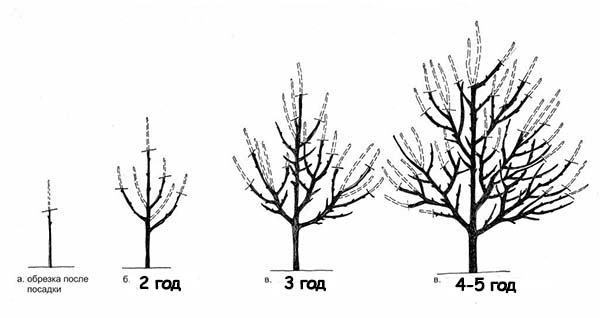
How to bowl cherries: pruning a 1, 2 year old tree
If you want to form a sweet cherry in the form of a bowl (simple), then pruning is carried out in the following sequence (by year):
- Immediately after spring planting or at 1 year - in the absence of branching (side branches) on the seedling, you need to cut the main branch (central conductor) to a height of 50-60 cm (60-80 is possible), so that the tree has side branches.
Note! As a rule, a 1-2 year old seedling is already planted., i.e. if the seedling already has branches, so see the next step.
- Next year (2 years) - the tree has lateral branches, which should be shortened by 1/3 (leaving 30-50 cm) on the outer bud. At the same time, you need to leave only 3-4 of the strongest (those growing close to the ground also do not fit), growing at an angle (rather horizontally than vertically) in different directions. Also, by transferring to the side shoot, the top should be cut off onto the ring.
- For the 2nd or 3rd year ... One-year increments were formed on each of the lateral branches. Now you need to choose 2-3 shoots on each of the branches, and all the rest, which are located close to the trunk and thicken the crown, are cut into a ring. The 2-3 remaining shoots are shortened by about 1/3, leaving 30-50 cm each.
As a result, your tree in the form of a bowl should have 8-12 main branches (3-4 of the first order and 4-8 of the second), from which you will receive a harvest from year to year.
Naturally, in the future you will have to trim them - regulate their growth and carry out anti-aging pruning.
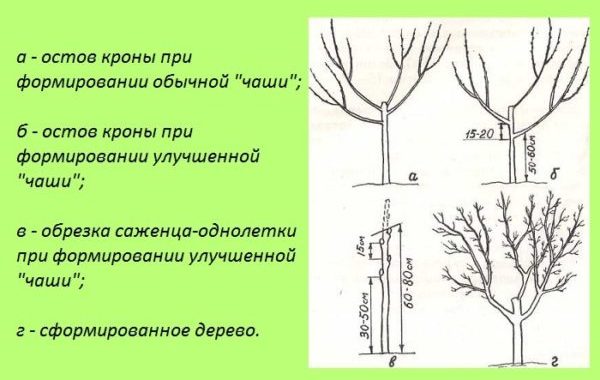
Rejuvenating old cherries
If you have an old sweet cherry in your garden that bears little fruit, then rejuvenating pruning can and should be carried out to improve yield and increase its life.
However, first you need to make sure that the selected tree is old but healthy, in other words, whether it is sick. Otherwise, rejuvenation will only hasten its death.
The essence of rejuvenating cherry pruning in spring is to replace old branches with new, younger and more fertile ones.
Important! Moreover, the rejuvenation of old trees should be carried out gradually, over several years. In other words, pruning should be moderate; you don't need to cut everything (listed below) in the first year.
If you remove too many branches at oncethen cherry, maybe shut up (release a lot of tops). However, everything can be easy fix summer pinching (removal of green young shoots - tops, if they grew "not there" or went to grow "not there").
Step-by-step instructions for rejuvenating pruning of old cherries in spring:
Remember! It is only necessary to prune "for a ring" by removing "for transfer" (for lateral branching), this is how old branches are replaced by younger ones - rejuvenating pruning is carried out.
- First of all, all diseased, dry and broken branches are subject to removal (sanitary pruning).
- Next, you need to get rid of the lower branches, which literally hang above the ground.
- Completely cut out "on the ring" all unnecessary and interfering branches that thicken and shade the crown (growing inside the crown, crossing, competing, growing with a "fork").
During rejuvenation, the advice is especially relevant that it is better to remove one large old branch than to cut or prune ("bud") a huge number of young thin shoots.
- Get rid of all tops (vertical branches - "wen"), again "on the ring".
Advice! Tops can be used for grafting cherries.
- Pinch (cut to the "bud") all young shoots, the height of which is more than 40-50 cm.
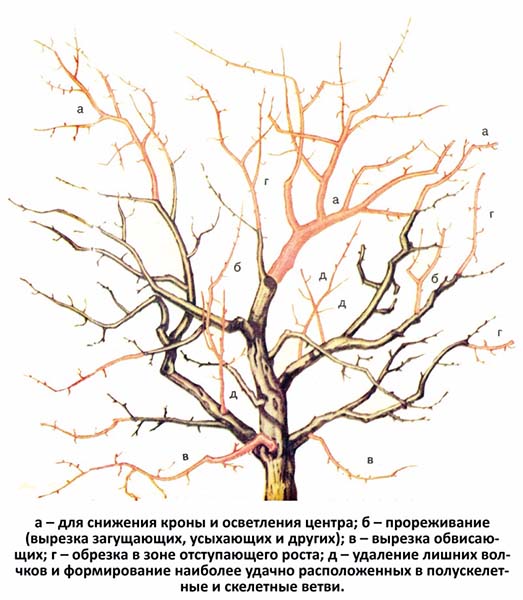
Video: pruning adult cherries
You can also watch this detailed video on the principles of anti-aging pruning of old trees:
Video: how to prune an old and neglected tree - spring pruning
How to hold a crown or what to do if a tree grows up
In short, you need to cut off all branches that are difficult to reach during harvest, but this must be done correctly.
Obviously, trees cannot be left unattended. It is enough not to cut the cherries for a couple of years to make them fly up.
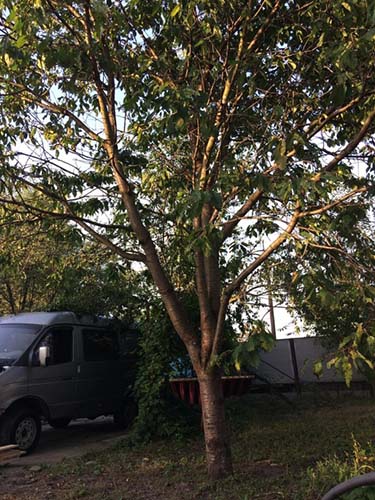
Interesting! If you do not control the growth of cherries, then they can grow up to 15 winds and become like palm trees, whose fruits you can hardly get to.
So that you can fine harvest and spend processing of cherries from diseases and pests, restraining the crown of the tree is simply necessary.
That is why, first of all, in this situation you need to spend thinning pruning, and at the end - remove all the highest vertical shoots "transfer to the ring " to the side, i.e. cut off high horizontal branches to one of the branches. So every year you can cut lower and lower until you reach the desired height. In other words, translate the direction of growth of the main branches to a horizontal position.
Advice! However, all vertical branches should not be cut out at a time, but you can enhance their fruiting by making small ones above each vegetative (growth) bud notches with a hacksaw, which will cause the formation of shoots on which flower (fruit) buds will be laid.
Can also be shortened by 1/3 all last year's growth on the branches left, which formed at the tips of the upper branches, i.e. at the very top, "Kidney".
Moreover, in this way you need to do every spring, because the tree must grow somewhere and give a one-year growth every year.
Video: pruning neglected cherries in order to reduce the crown
Popular mistakes that occur during spring pruning of cherries among beginners
Sometimes even experienced summer residents can make offensive mistakes, so it is important to know them in advance, so as not to check them again on their own experience. After all, this can lead to improper development of the tree in the future or cause a long recovery, which will affect its yield.
So, the most common mistake when pruning cherries and other fruit trees is improper pruning. "On the kidney", when pruning is done either below the kidney (in which case it can freeze out), or too large a stump is left (which simply does not heal, it can rot and an infection will surely get through it). Correct cut must be done just above the kidney. Wherein bud should be at the level bottom cut.
Likewise cropping "On the ring"when you leave too much foam, on which completely useless branches then grow, only taking away the strength from the tree. Moreover, the stump itself gradually begins to rot, its bark flakes off. Also, you cannot (it is even more dangerous) cut too low, with the ring removed.
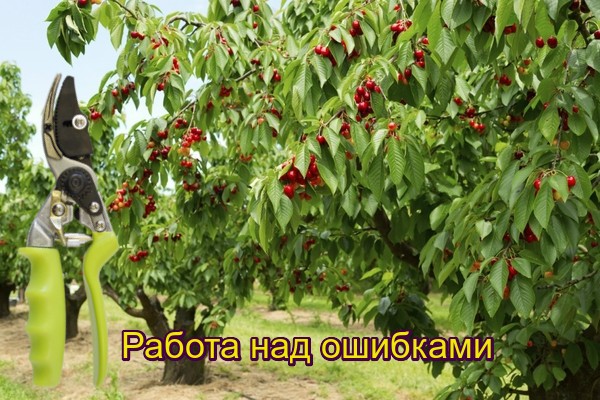
Other common mistakes beginners make during spring pruning are:
- Pruning is carried out in wrong timing... The worst time for pruning is the middle of summer, therefore, if you carry out the procedure at this time, you can weaken the tree for a long time and slow down its growth. It is better then in the fall (after leaf fall), but optimally - in early spring, before bud break.
- Not cut sick, dry and broken branches (sanitary pruning is not carried out).
- Remains too many extra branches, which shade the crown and do not allow it to blow normally (no air access).
- No need for special prune old branches on which mosses and lichens.
It's another matter if young thin branches of trees are covered with moss, then in this case you need a rejuvenating pruning of the entire tree (especially old branches).
- Wrongly conducted shaping.
- Subordination is not made branches, that is, the branches of the lower tier become weaker than the following, which leads to their death, overestimation of the stem and the formation of fruits especially in the upper part of the tree.
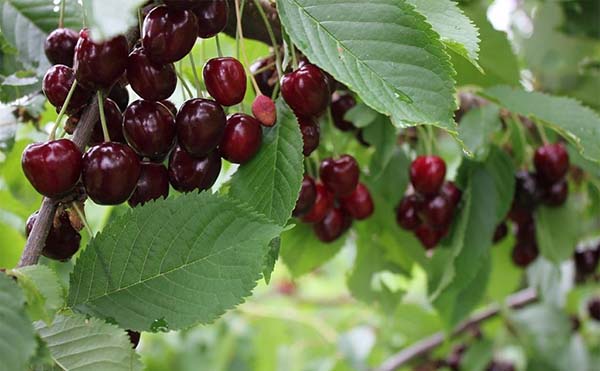
Thus, pruning cherries in spring is, although quite difficult, but a very important and useful procedure, thanks to which you can enjoy delicious and sweet fruits every year.Indeed, as you know, only a healthy tree with a properly formed crown can give stable yields. Good luck with your garden surgery!
Video: pruning cherries
Of course, when you read and see diagrams, pictures, then everything seems simple and easy. But for some reason, when you approach your tree, everything becomes incomprehensible.
Well, that's okay. The main thing - no need to be afraid and just practice more often, because everything comes with experience.
In addition, pruning is, in a sense, a creative process: after all, the same branch (skeletal) can be pruned in different ways.
Advice! Alternatively, you can print yourself a cheat sheet with all the schemes and cropping rules.

